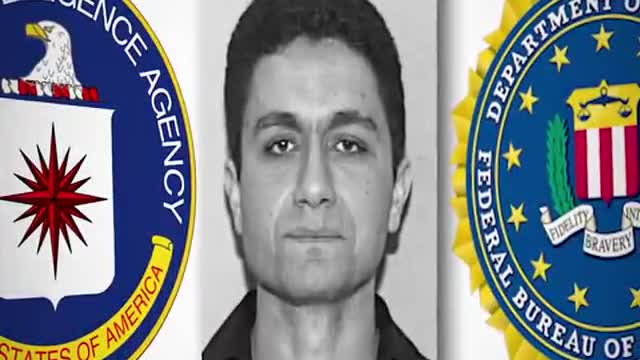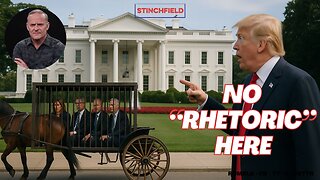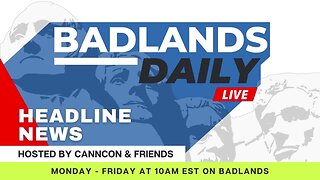Premium Only Content

FALSE FLAGS: THE SECRET HISTORY OF AL QAEDA (PART 3)
TRANSCRIPT
"Falsehood flies, and truth comes limping after it, so that when men come to be undeceived, it is too late; the jest is over, and the tale hath had its effect."
Jonathan Swift
INTRODUCTION
Kabul, Afghanistan. August 29th, 2021.
A white 1996 Toyota Corolla races down the dusty streets of the Afghan capital.
Just days earlier, a suicide bombing at the Kabul airport had killed thirteen US Marines and dozens of Afghans. American forces, on high alert, track the Corolla from above. An American MQ-9 Reaper drone hovers high up, monitoring the driver—Zemari Ahmadi—as he stops at a suspected ISIS safe house and loads the car with explosives before continuing his journey to the airport.
But Ahmadi never reaches his destination. At 4:50 PM, the order is given and the Reaper drone launches a hellfire missile at the vehicle, killing the would-be terrorist and destroying his explosive payload.
The media, focused on the conflict in Afghanistan for the first time in years, air live coverage of the Pentagon's announcement: In the waning hours of America's two-decade-long military presence in Afghanistan, another terror threat has been liquidated and more innocent lives have been saved.
GEN. WILLIAM TAYLOR: Yesterday, US military forces conducted an over-the-horizon counterterrorism operation against an ISIS-K planner and facilitator. The air strike occurred in the Nangarhar province of Afghanistan. I can confirm, as more information has come in, that two high-profile ISIS targets were killed and one was wounded and we know of zero civilian casualties.
SOURCE: Military officials hold news conference at Pentagon after drone strike
But as the smoke cleared on the scene of the strike, some grisly truths began to emerge: Ahmadi had not been a terrorist. He was not on his way to set off a suicide bomb at the Kabul Airport. The car didn't even have explosives.
In reality, Ahmadi had been an aid worker for an American NGO distributing food to malnourished Afghans. He wasn't on his way to the airport; he was arriving home after a day at the office. The "suspicious packages" that the drone operators had watched him load into his car were in fact water bottles that Ahmadi was bringing home because his neighbourhood was dealing with a water shortage.
In perhaps the greatest irony, Ahmadi had applied for a special visa to emigrate to the US with his family just days before his death. Now, that family was devastated, torn apart by an explosion that left Ahmadi and nine of his relatives—including a two-year-old—dead.
Finally forced to admit that every part of the drone strike story had been a lie, the Pentagon called it a "tragic mistake." And, after a three-month self-investigation, it was decided that no one involved in that "mistake" would receive any punishment for killing 10 innocent Afghans.
The story of the killing of Zemari Ahmadi is the story of the War on Terror in a nutshell. Ahmadi's death was cast as a "tragic mistake" for which no one was to blame, just as America's decades-long debacle in the Middle East—from the invasion, occupation and eventual choatic retreat from Afghanistan to the illegal invasion of Iraq and the rise of ISIS to the regime change operations in Libya and Syria—had been a "failure" of military planning.
But, when viewed in its proper context, the war on terror was no failure. In fact, waged on fictitious grounds against a shadow enemy, the great military campaign of the 21st century was not a war on terror at all. It was a war of terror, a pretext for the construction of an international security grid in the name of fighting a bogeyman that never existed in the first place.
And by that metric, the war of terror was successful beyond its planners' wildest dreams.
Part Three: The War of Terror
For many in the general public, the war on terror was a direct consequence of 9/11, and that war began with George W. Bush's address to Congress on September 20, 2001:
GEORGE W. BUSH: Our enemy is a radical network of terrorists, and every government that supports them. Our war on terror begins with Al Qaeda, but it does not end there. It will not end until every terrorist group of global reach has been found, stopped, and defeated.
SOURCE: President Bush's address to a joint session of Congress on September 20, 2001
Some even believe that the war ended with Barack Obama's declaration of May 23, 2013:
BARACK OBAMA: Beyond Afghanistan, we must define our effort not as a boundless “global war on terror,” but rather as a series of persistent, targeted efforts to dismantle specific networks of violent extremists that threaten America.
SOURCE: Remarks by the President at the National Defense University
But, as convenient as these statements are for creating bookends for the story of the war on terror, they do not tell the real story of that war. In fact, the origins of the global war on terror go back much further than the general public has been led to believe.
In 1962, the US Joint Chiefs of Staff, led by General Lyman Lemnitzer, issued a startling proposal to President John F. Kennedy on how to get the public on board with military invention in Cuba to remove Fidel Castro from power. Called Operation Northwoods, the plan suggested a number of staged provocations, secretly committed by the US itself but blamed on Castro, including: blowing up a US ship in Guantanomo Bay and blaming the incident on the Cuban government; staging terror attacks in the United States to be blamed on Cuban terrorists; and even painting up a remote-controlled plane to resemble a passenger jet and destroying it over Cuba.
The incredible plan, rejected by Kennedy, who subsequently refused to renew Lemnitzer's term as Chairman of the Joint Chiefs of Staff, was classified and was not revealed to the public until 2001, just months before 9/11.
JAMES BAMFORD: The idea was to create a pretext to show that the there was an attack by Cuba on the United States. And the idea was to have US personnel from the CIA and other places secretly create terrorism in the United States. The document actually said people would be shot on American streets, bombs would be blown up. And again, all this the evidence would be laid to point the finger at Castro.
One other idea was they were going to—they had a very complex plan where they were going to take an aircraft and load it with CIA people that looked like college students, fly it over to—have it take off from an airport in Miami with a lot of publicity and then it would—quickly after it got into the air—land at a secret CIA base. At that same time, an identical plane would take off from that CIA base, except this plane would be empty and it would be remotely piloted from the ground. It would be a drone plane that would be very similar to the passenger plane that had just taken off.
And once the plane was over Cuba, there was going to be a tape recorder that would have played a distress call to a microphone saying, "Help, we're being shot at!" And a few minutes later—once the plane was over the Caribbean Sea after it passed over Cuba—somebody would have pressed the button on the ground, blowing up the plane. And they would have blamed Cuba for killing a plane load of American college students.
SOURCE: Operation Northwoods explained by James Bamford
But even after its rejection, the Northwoods idea of using spectacular terror attacks as the justification for a widescale war continued to be employed by military planners.
In November 1998, Philip Zelikow—who would go on to chair the 9/11 Commission—co-wrote an article in Foreign Affairs, the Council on Foreign Relations' publication, with Ashton Carter, the future Secretary of Defense under President Obama, and John Deutsch, the former director of the CIA. Titled "Catastrophic Terrorism: Tackling the New Danger," the article warns of a potential "transforming event," such as an attack on the World Trade Center:
"Like Pearl Harbor, the event would divide our past and future into a before and after. The United States might respond with draconian measures scaling back civil liberties, allowing wider surveillance of citizens, detention of suspects and use of deadly force. More violence could follow, either future terrorist attacks or U.S. counterattacks. Belatedly, Americans would judge their leaders negligent for not addressing terrorism more urgently."
The solution to this impending threat of catastrophic terrorism, Zelikow and his co-authors argue, is to take that threat seriously—as the US government did in 1940 when it "pondered what kind of forces it would need to wage a global war"—and to create new offices for coordinating homeland security and waging pre-emptive strikes against potential terrorists around the world.
Then, unnoticed by much of the public, the global war on terror was first proposed on live TV on the morning of 9/11. At 11:28 AM New York time, as the blanket of dust from the freshly exploded towers was still settling on Manhattan and much of the world was still trying to process what was happening, a guest on BBC World News laid out the dawning of the new age of global terror with remarkable foresight. But this prediction was not delivered by a US government official or an American intelligence agent or a Washington Beltway insider. It was delivered by Ehud Barak, the former Prime Minister of Israel.
PRESENTER: Joining me now here in the BBC World studio is the former Israeli Prime Minister Ehud Barak, who's in London at the moment. Mr. Barak, welcome to BBC World. First, your reaction, having heard what's happened. At least four planes have been hijacked and there may be more.
EHUD BARAK: The world will not be the same from today on. It's an attack against our whole civilization. I don't know who is responsible. I believe we will know in 12 hours.
If it is a kind of bin Laden organization, and even if it's something else, I believe that this is the time to deploy a globally concerted effort led by the United States, the UK, Europe and Russia against all sources of terror—the same kind of struggle that our forefathers launched against the piracy on the high seas.
SOURCE: September 11, 2001 - 11:28am EDT (4:28pm BST) - BBC World News
In the chaos of September 11, 2001, mere minutes after the destruction of the Twin Towers, the global viewing public was presented all the key takeaways of 9/11: that "this is the time to deploy a globally concerted effort led by the United States"; that "the world will not be the same from today on"; and, of course, that we "don't know who was responsible," although "we will know in 12 hours." But the name immediately implanted in the minds of the audience—not for the first nor the last time on that long day of news coverage—was that of Osama bin Laden.
In the following days, these takeaways became the talking points for the US government and its allies around the world. Before the day was over, President Bush was already laying the rhetorical groundwork for the coming war, vowing that "we stand together to win the war against terrorism." By the end of the week, the American public was being prepared for a conflict much bigger than a conventional war: "This crusade, this war on terrorism is going to take a while."
And, in the following week, Bush confirmed what the public had been told since the moment of the live televised strike on the World Trade Center:
JON SCOTT: We just saw on live television as a second plane flew into the second tower of the World Trade Center. Now, given what has been going on around the world, some of the key suspects come to mind: Osama bin Laden. Who knows what?
SOURCE: Original News Broadcast on 9/11/01
BUSH: Americans are asking: Who attacked our country? The evidence we have gathered all points to a collection of loosely affiliated terrorist organizations known as Al Qaeda.
SOURCE: President Bush's address to a joint session of Congress on September 20, 2001
By the end of the month, the public had heard so many authoritative pronouncements about "the evidence" pointing to bin Laden's responsibility for the 9/11 attacks that few noticed when the US government declined to release a promised white paper outlining that evidence—a decision prompted by a "lack of solid information" about the plot, according to government sources cited by veteran journalist Seymour Hersh. Instead, the presentation of such evidence was outsourced—as so much of the dirty work in the global war on terror would be—to a third-party nation-state: the United Kingdom.
On September 30, 2001, UK Prime Minister Tony Blair appeared on the BBC's Breakfast with Frost program to declare he had been shown "absolutely powerful, incontrovertible evidence of [bin Laden's] link to the events of the 11th of September," but because the evidence came from "sensitive sources" he could not simply reveal it to the public. Rather, the UK government would release a report laying out its case against Osama in great detail.
That dossier, titled "Responsibility for the terrorist atrocities in the United States," was released on October 4th and was touted by the press as "the clearest case yet of Osama bin Laden's involvement in the September 11 attacks." The document opens, however, by noting that it "does not purport to provide a prosecutable case against Osama bin Laden in a court of law." The first 60 points of the report provide general background information about bin Laden and previous terror attacks attributed to Al Qaeda, and the last ten points, dealing with "Osama bin Laden and the 11 September attacks," are almost incomprehensibly vague.
It claims that "at least three" of the hijackers have been identified as "associates of Al Qaeda," without listing how this conclusion was arrived at or even who these associates are.
It claims that the attack "follows the modus operandi" of Al Qaeda and is "entirely consistent" with the planning of previous attacks attributed to the group.
And, most remarkably, it states that "[t]here is evidence of a very specific nature relating to the guilt of bin Laden and his associates that is too sensitive to release."
At almost the exact same time, momentous events were taking place in Europe, where the North Atlantic Council, NATO's main decision-making body, was receiving a classified briefing from a US State Department operative.
LORD ROBERTSON: This morning, the United States briefed the North Atlantic Council on the results of their investigation into who was responsible for the horrific terrorist attacks which took place on 11 September.
The briefing was given by Ambassador Frank Taylor, the United States Department of State Coordinator for Counter-terrorism.
[. . .]
The briefing addressed the events of 11 September themselves, the results of the investigation so far, what is known about Osama bin Laden and the Al Qaeda organization and their involvement in the attacks and in previous terrorist activity, and the links between Al Qaeda and the Taliban regime in Afghanistan.
The facts are clear and compelling. The information presented points conclusively to an Al Qaeda role in the 11 September attacks.
SOURCE: Statement by NATO Secretary General, Lord Robertson, October 2, 2001
This was no ordinary briefing. The result of that briefing was that for the first time in its history, NATO invoked Article 5 of its charter—the self-defence clause that compels the organization to assist any member nation that is attacked by an outside force. By "proving" that bin Laden had committed the attack in connection with the Taliban, the United States could launch the war on terror and compel NATO to assist in its invasion of Afghanistan.
LORD ROBERTSON: On the basis of this briefing, it has now been determined that the attack against the United States on 11 September was directed from abroad and shall therefore be regarded as an action covered by Article 5 of the Washington Treaty, which states that an armed attack on one or more of the Allies in Europe or North America shall be considered an attack against them all.
I want to reiterate that the United States of America can rely on the full support of its 18 NATO allies in the campaign against terrorism.
Given the stakes involved, questions long swirled around this mysterious, classified briefing. What had Ambassador Frank Taylor told the North Atlantic Council that was so compelling? What information persuaded the world's largest and most powerful military alliance to launch an invasion of another nation? The public, it seemed, would never know.
LORD ROBERTSON: Today's was a classified briefing and so I cannot give you all the details. Briefings are also being given directly by the United States to the Allies in their capitals.
But then, in 2009, intelwire.com quietly posted a document online under the title "Secret Post-9/11 Briefing to World Leaders." The document is a US State Department cable addressed to the American embassies in the NATO countries and American allies around the world under the subject line "September 11: Working together to fight the plague of global terrorism and the case against Al Qaeda." The cable is dated October 1, 2001—the day before Ambassador Taylor's meeting with the North Atlantic Council—and instructs its recipients to brief their host country's government on "the information linking the Al Qaeda terrorist network, Osama bin Laden, and the Taliban regime to the September 11 terrorist attack on the World Trade Center and Pentagon and the crash of United Airlines Flight 93."
The document went largely unnoticed until 2018, when Professor Niels Harrit wrote an article, "The Mysterious Frank Taylor Report: The 9/11 Document that Launched US-NATO’s 'War on Terrorism' in the Middle East," connecting the dots between this document and the briefing that Ambassador Taylor gave to the North Atlantic Council.
HARRIT: This is in my mind with no doubt simply the legal basis for eighteen years of perpetual war in the Middle East. This is the basis for NATO's activation of Article 5. And so what is in the document and what is the evidence? What is the evidence which Lord Robertson calls "clear and compelling"? None. There's absolutely no evidence in that paper.
SOURCE: The Secret Lie That Started the Afghan War
Much like the UK government dossier, the State Department cable contains no actual evidence of a link between bin Laden and the 9/11 attacks. In fact, the cable is virtually identical to the UK report. After spending a full fifteen pages talking in generalities about terror, about the US government's officially sanctioned history of Al Qaeda, and of previous attacks attributed to Al Qaeda and Osama bin Laden, the document finally arrives at "Part III" purporting to demonstrate Al Qaeda's involvement in the attacks.
But Part III begins by admitting that the investigation into the attacks is "still in the early stage" and that "[t]here are still gaps in our knowledge." It then goes on to detail circumstantial "evidence," including the observation that "bin Laden and his associates seemed to be anticipating what we could only identify as an important event or activity." Finally, the document talks about how the incident is "tactically similar to earlier attacks" because it involved planning and a desire to inflict mass casualties.
And with that complete lack of evidence, the war on terror was launched and the invasion of Afghanistan began.
And so, in October 2001, the bombs began dropping on Afghanistan. The war of terror had officially begun, and the public was told that one of the key objectives of that war was to kill or capture Osama bin Laden.
REPORTER: Do you want bin Laden dead?
BUSH: I want him . . . hell, I want justice. And there's an old poster out West, as I recall, that said "Wanted: Dead or Alive."
SOURCE: CNN: 2001, President George W. Bush 'bin Laden, Wanted dead or alive'
But as we have seen, one of the defining hallmarks of Al Qaeda throughout its reign of terror was its agents' uncanny ability to cross borders illegally, evade capture repeatedly and generally slip through intelligence agency dragnets unimpeded. This remarkable string of "good luck" included:
the "Blind Sheik" Omar Abdel Rahman, who entered the US with CIA support and lived there unmolested even after his green card was revoked;
World Trade Center bomber Ramzi Yousef, who entered the US without the proper paperwork, working and living with a suspected terror ring that was under FBI surveillance, and fleeing the country before he was even a person of interest in the WTC investigation;
Khalid Al-Mihdhar and Nawaf Alhazmi, whose entry to the US from an Al Qaeda summit in Malaysia was known about and actively covered up by the CIA and who lived openly in the United States under their real names for over a year, repeatedly calling the Al Qaeda communications hub in Yemen that was being monitored by the NSA;
and, most infamously, Al Qaeda "triple agent" Ali Mohammed, whose career as an Egyptian army officer, a "failed" CIA asset, a trusted aide to Al Qaeda second-in-command Ayman Al-Zawahiri, a US special forces training officer, a volunteer fighter in Afghanistan, an FBI deep-cover asset, Osama bin Laden's personal bodyguard and the trainer of many of Al Qaeda's terrorists throughout the 1990s is so improbable that it is generally ignored in most histories of Al Qaeda.
As incredible as all of those stories are, however, they pale in comparison to the story that was about to unfold: the "disappearance" of Osama bin Laden, ostensibly the most wanted man on the planet, from under the noses of the American military and intelligence services.
Osama bin Laden's remarkable post-9/11 "disappearance" actually began on 9/11 itself, when his whereabouts were not a mystery to America or its allies in the region. In fact, his location and activities on the night before 9/11 were well known to the US, although that information would not be revealed to the public until after his "escape."
BARRY PETERSEN: Everyone remembers what happened on September 11th. Here's the story of what may have happened the night before. It is a tale as twisted as the hunt for Osama bin Laden.
CBS News has been told that the night before the September 11th terrorist attack, Osama bin Laden was in Pakistan. He was getting medical treatment with the support of the very military that days later pledged its backing for the US war on terror in Afghanistan. Pakistan intelligence sources tell CBS News that bin Laden was spirited into this military hospital in Rawalpindi for kidney dialysis treatment.
SOURCE: Dan Rather Reports: 9/11 bin Laden At Rawalpindi Hospital September 10th 2001
Despite knowing bin Laden's precise location and activities right up to the moment of 9/11, however, and despite the fact that the Al Qaeda leader was already a wanted fugitive subject to international arrest warrants and under indictment by a US federal court, bin Laden continued to move around internationally with the full knowledge and complicity of state intelligence services. And, as remarkable as this may seem, bin Laden's trip to Rawalpindi on the eve of 9/11 was neither the first nor the last time that the US would allow him to evade capture.
In the weeks after the attack, the Taliban offered to try bin Laden in Afghanistan or even hand him over to a third-party country if the US provided them with the same proof of Bin Laden's guilt for 9/11 that Ambassador Taylor had supposedly provided NATO. Bush turned the offer down. Then, after the invasion of Afghanistan began in October, the Taliban again tried to hand bin Laden over, this time dropping the request for proof of his guilt. Bush again refused.
The war of terror, it turned out, was not about getting Osama. In fact, if bin Laden had been captured or killed, it would have derailed the carefully laid plans for the Bush Administration's aggressive new foreign policy.
But, having been sold on the simplified version of the war on terror—the one that held the objective of that war was to kill or capture Osama bin Laden and to liquidate the Al Qaeda network—the public believed that the fighting would be short and decisive, like the first Gulf War. After all, how hard would it be for the army of the world's unrivaled military superpower employing the tools of the most high-tech intelligence community in history to capture a lone fighter on dialysis in the caves of Tora Bora?
Bush administration officials were quick to temper the public's expectations on this point. This was no ordinary elderly man living in an undefended cave, after all. This was a comic book supervillain, an evil millionaire mastermind directing a terrorist army from his elaborate cave fortress.
TIM RUSSERT: . . . there is constant discussion about him hiding out in caves, and I think many times the American people have a perception that it's a little hole dug out of a side of a mountain.
DONALD RUMSFELD: Oh, no.
RUSSERT: This is it. This is a fortress! A complex, multi-tiered. Bedrooms and offices on the top, as you can see. Secret exits on the side and on the bottom. Cut deep to avoid thermal detection. A ventilation system to allow people to breathe and to carry on. The entrances large enough to drive trucks and even tanks. Even computer systems and telephone systems. It's a very sophisticated operation.
RUMSFELD: Oh, you bet. This is serious business. And there's not one of those, there are many of those!
SOURCE: Bin Laden's cave according to Rumsfeld
This was a lie, of course. There were no high-tech cave fortresses, no "multi-tiered bedrooms and offices on the top," no "secret exits on the side," no ventilation system or computer systems. It was a fabrication, a literal artist's rendering with as much reality as that of a comic book or a cartoon.
But, as an unfolding drama for the public following the war on their television sets half a world away, this story had enough twists and turns to keep any audience engaged.
The first phase of the war went as predicted. By November, America's relentless bombing had already routed the Taliban, driving them from Kabul toward Kunduz in the north. There, the trapped fighters—including not only Taliban but Al Qaeda members as well as Pakistani Army officers, intelligence advisers, and volunteers—were saved from certain defeat by a miracle: the arrival of a squadron of Pakistani aircraft that flew in and airlifted them back to Pakistan.
It was later confirmed that the operation—dubbed the "airlift of evil"—was signed off on by the Bush Administration, who had cut a secret deal with Pakistani President Musharraf to let the fighters escape and who "ordered the United States Central Command to set up a special air corridor to help insure the safety of the Pakistani rescue flights."
But what about Osama bin Laden? As it turns out, his whereabouts were no great mystery to American forces, and, once again, he was allowed to escape.
On the eve of the invasion of Afghanistan in October, the Guardian reported that "Osama bin Laden was in Kabul last week and US and British intelligence agencies have a 'pretty good idea' where he is now," suggesting that "Western intelligence has a much clearer picture of bin Laden's recent movements than has been admitted." The report went on to note that bin Laden's "capture or death would reduce the pressure for wider military action against Afghanistan." But this intelligence did not lead to bin Laden's apprehension.
As American forces honed in on Kabul in early November, bin Laden and all of his closest advisors managed to escape to Jalalabad in a very conspicuous late-night convoy. One eyewitness reported: "We don't understand how they weren't all killed the night before, because they came in a convoy of at least 1,000 cars and trucks. It was a very dark night, but it must have been easy for American pilots to see the headlights."
On November 13th, just one day before the Northern Alliance captured Jalalabad, bin Laden escaped once again, this time in a convoy of several hundred cars. Despite believing bin Laden to be in one of the vehicles, US forces opted to ignore the convoy and instead bombed the nearby Jalalabad airport.
Bin Laden and his men, now numbering a few hundred fighters, arrived in mid-November at the mountainous Khyber Pass on the border of Pakistan. On November 15th, with the remaining Al Qaeda and Taliban holdouts pinned down in the caves of Tora Bora, the US military was in a position to eliminate the Al Qaeda threat, kill Osama bin Laden and end the war on terror.
But, remarkably, the Marines, special forces and CIA operatives who were positioned and ready to do this were blocked from doing so by their own superiors.
NARRATOR: That winter, the CIA was still at war. The Taliban had fallen. Now it was Osama bin Laden's turn.
GARY BERNTSEN: I'm looking for bin Laden right away. I want to start killing him and his people immediately.
GARY SCHROEN: We had intelligence that continued to develop that bin Laden and Zawahiri were in Afghanistan, probably in the eastern areas, hiding out there.
NARRATOR: The CIA tried to put together a team to chase bin Laden. It wasn't easy.
GARY BERNTSEN: I asked Army special forces if they'll send people in. They say, "No, we're not going down there. It's unstable. You don't have a reliable ally."
STEVE COLL: The conditions for Al Qaeda's retreat were quite favorable, and the United States did not do the one thing that the Pentagon had within its power to do, which was to move regular US troops into a blocking position behind these mountains.
SOURCE: The Dark Side (Frontline)
The story, exhaustively documented by CIA operatives, special forces operators, journalists and even a US Senate report, is clear and unambiguous.
As the US Senate report notes: "By early December 2001, bin Laden’s world had shrunk to a complex of caves and tunnels carved into a mountainous section of eastern Afghanistan known as Tora Bora."
Both the CIA and Delta Force—the US Army's elite special operations unit—had tracked bin Laden from Jalalabad to Tora Bora. They had "real-time eavesdropping capabilities on Al Qaeda almost from their arrival, allowing them to track movements and gauge the effectiveness of the bombing" and were able to pick up radio communications featuring bin Laden directly issuing commands to his troops. They had him surrounded on three sides, and the relentless air strikes—including the use of a 15,000 pound "daisy cutter" not used since Vietnam—were decimating what was left of bin Laden's forces. All that was needed was to secure the mountain pass leading out of Tora Bora and into Pakistan.
Gary Berntsen, the head of the CIA's paramilitary operation against the Taliban and Al Qaeda, knew that the Afghan militias that the US had cobbled together were not up to the job of securing the pass. From mid-November to mid-December, he repeatedly begged his superiors for one battalion of US Army Rangers—just 800 troops—to help stop bin Laden from slipping away.
As the US Senate later noted, fulfilling Berntsen's request "would have been a manageable task":
In late November, about the time US intelligence placed bin Laden squarely at Tora Bora, more than 1,000 members of the 15th and 26th Marine Expeditionary Units, among the military’s most mobile arms, established a base southwest of Kandahar, only a few hours flight away. [. . .] Another 1,000 troops from the Army’s 10th Mountain Division were split between a base in southern Uzbekistan and Bagram Air Base, a short helicopter flight from Tora Bora.
General James Mattis, the commander of the Marines at Kandahar, told a journalist that his troops could seal off Tora Bora, but his superiors rejected the plan.
Berntsen fared no better in his quest to obtain 800 Army Rangers for the mission. Not only was his request rejected, but, remarkably, in the middle of the most important battle of the war, he was replaced as head of the CIA force in Afghanistan, effective immediately. His replacement was to be Rich Blee, the same CIA bin Laden unit chief who had helped conceal the information about Al-Mihdhar and Alhazmi's entry to the US from the FBI. Blee was accompanied to Afghanistan by Michael Anne Casey, the bin Laden unit staffer who had actually stopped Doug Miller from sharing that info with the FBI.
At first, Berntsen was told that his request was denied because it might "alienate our Afghan allies."
"I don't give a damn about alienating our allies!" he replied. "I only care about eliminating Al Qaeda and delivering bin Laden's head in a box!"
Later, though, a different story emerged. As it turns out, at the exact same time that bin Laden was holed up in Tora Bora, US Defense Secretary Donald Rumsfeld ordered General Tommy Franks, who was leading the Afghan invasion, to redirect planning resources from Afghanistan to the Pentagon's next target in the war of terror: Iraq.
As even the official story of the war on terror acknowledges, bin Laden and his top aides, seizing their opportunity, simply walked out of Tora Bora and into Pakistan.
And, just like that, the bogeyman of the war on terror was gone, allowed to escape yet again. He would reappear from time to time to continue reminding the public about the origins of the terror war. But now, the public's attention was being turned to a new bogeyman.
QUESTION: Mr. President, in your speeches now, you rarely talk [about] or mention Osama bin Laden. Why is that?
Also, can you can tell the American people if you have any more information—if you know if he is dead or alive. Deep in your heart, don't you truly believe that until you find out if he is dead or alive, you won't really want to make—
BUSH: Well, deep in my heart, I know the man's on the run if he's alive at all. And I—you know, who knows if he's hiding in some cave or not? We hadn't heard from him in a long time.
And the idea of focusing on one person is really—indicates to me people don't understand the scope of the mission. Terror's bigger than one person. And he's just—he's a person who has now been marginalized. His network is—his host government has been destroyed. He's the ultimate parasite who found weakness, exploited it, and met his match.
He is—you know, as I mention in my speeches—I do mention the fact that this is a fellow who is willing to commit youngsters to their death. And he, himself, tries to hide, if, in fact, he's hiding at all.
So I don't know where he is. Nor—you know, I just don't spend that much time on him really, to be honest with you.
SOURCE: Presidential News Conference March 13, 2002
BUSH: Some have argued that confronting the threat from Iraq could detract from the war against terror. To the contrary, confronting the threat posed by Iraq is crucial to winning the war on terror.
SOURCE: President Bush Outlines Iraqi Threat
That the Bush Administration would pivot so quickly from hunting Osama bin Laden to toppling Saddam Hussein was only surprising to those who did not know the neocons populating the Bush administration or their well-documented and long-held desire to affect regime change in Iraq.
In 1996, a group of prominent neoconservatives—including Richard Perle, Douglas Feith and David Wurmser—wrote a report for then-Israeli Prime Minister Benjamin Netanyahu. Titled "A Clean Break: A New Strategy for Securing the Realm," the report urged Israel to "shape its strategic environment" by "weakening, containing, and even rolling back Syria." The way to do this, the report concluded, was to "focus on removing Saddam Hussein from power in Iraq—an important Israeli strategic objective in its own right—as a means of foiling Syria’s regional ambitions."
In 1997, twenty-five prominent neocons—including ten who would go on to serve in the Bush Administration, and even Jeb Bush, the future president's brother—signed a "Statement of Principles" as the founding charter of a new think tank called the Project for the New American Century (PNAC). The statement called on then-President Clinton to reverse the defense spending cuts that marked the post-Cold War era and to "increase defense spending significantly." In 1998, the group followed up with an open letter to Clinton urging him to "turn your Administration's attention to implementing a strategy for removing Saddam's regime from power."
Surrounding himself with neocons on the campaign trail and eventually installing those neocons in all of the key security positions in his cabinet, President George W. Bush wasted no time in making these regime change dreams a reality.
As Treasury Secretary Paul O'Neill later revealed, at his first major national security council meeting—held just ten days into the new administration—"President Bush tasked Secretary of Defense Donald Rumsfeld and Joint Chiefs of Staff Chairman Hugh Shelton to begin preparing options for the use of US ground forces in the northern and southern no-fly zones in Iraq to support an insurgency to bring down the Saddam regime." The second national security council meeting of the Bush administration, held two days later, also discussed regime change in Iraq, with one briefing document at the meeting marked "secret" and bearing the title "Plan for post-Saddam Iraq."
RON SUSKIND: From the very first instance, it was about Iraq, it was about what we can do to change this regime.
LESLEY STAHL: Now, everybody else thought that grew out of 9/11.
SUSKIND: No.
STAHL: But this book says it was day one of this administration.
SUSKIND: Day one, these things were laid and sealed.
SOURCE: Before 9/11, Bush Asked To “Go Find Me A Way” To Invade Iraq
And, infamously, on the day of 9/11 itself, the administration was already beginning plans for a retaliatory strike not just on bin Laden in Afghanistan but on Iraq.
A note taken at 2:40 PM on September 11, 2001, records Rumsfeld saying he wanted "best info fast. Judge whether good enough to hit Saddam Hussein at the same time. Not only bin Laden." He also made sure to order staff to "go massive" and "sweep it all up" including "things related and not."
From before Bush even got into office, there was no doubt that he would attack Iraq. 9/11 and the war on terror merely presented the neocons with the perfect opportunity to fulfill that agenda. The only problem was how to tie Iraq into the war on terror in the minds of the public, a problem that Bush himself admitted to.
BUSH: You know, one of the hardest parts of my job is to connect Iraq to the war on terror.
SOURCE: Couric Interview Bush September 6, 2006
BUSH: Of course we're after Saddam Hussein . . . I mean bin Laden. He's . . . he's . . . he's isolated.
SOURCE: George W. Bush and John Kerry 1st Presidential Debate 2004
The job of connecting the public face of the war on terror—bin Laden and Al Qaeda—to Saddam and Iraq was made more difficult by the fact that there was no such connection. Difficult, but not impossible, for a committed cadre with no qualms about using mendacity to achieve their political objectives.
The most direct link between Al Qaeda and Iraq was a trip that alleged 9/11 hijacker Mohammed Atta was reported to have made to the Iraqi consulate in Prague in April 2001. After Atta's pictures were published in the media in the wake of 9/11, a Middle East informant told Czech intelligence that he had seen Atta meeting with a suspected Iraqi intelligence agent in the Czech Republic that spring.
The story became even more salacious when—at the height of the anthrax scare in October 2001—"anonymous Israeli intelligence sources" planted a story in the German media that Atta had in fact received anthrax spores from his Iraqi contact in Prague.
But the entire story was such a preposterous lie that it was quickly disowned by both the FBI and the CIA. Investigators found "there was no evidence Atta left or returned to the US" during that time frame and "pointed to other evidence, including Atta's cell phone records, to cast doubt on the idea that any meeting had occurred." And, despite the fantastical, anonymous, evidence-free reports in German media, the anthrax used in the anthrax attacks on America in the fall of 2001 did not source from Iraq, but from the US military's own bioweapons laboratory.
None of this stopped Vice President Dick Cheney from repeating the lie in his media appearances in the run-up to the Iraq War, however.
CHENEY: We've seen, in connection with the hijackers, of course, Mohamed Atta, who was the lead hijacker, did apparently travel to Prague on a number of occasions. And on at least one occasion, we have reporting that places him in Prague with a senior Iraqi intelligence official a few months before the attack on the World Trade Center.
SOURCE: Cheney on "Meet the Press" September 8, 2002
The story of Iraqi agents handing flasks of anthrax to 9/11 hijackers was a little too fanciful even for the credulous American public, however, and it was soon dropped from the neocons' sales pitch for the Iraq war.
Instead, a different set of lies would need to be found to sell the public on the illegal invasion of a sovereign nation.
On January 31, 2003—six months after senior British intelligence complained behind closed doors that the "facts were being fixed around the policy" of invading Iraq—Bush met with British Prime Minister Tony Blair at the White House for a discussion on the matter. As a now-infamous memo documenting the meeting records, Bush had already decided on military action, and a start date for the bombing of March 10th "was now pencilled in." Given that it was unlikely that the UN would pass a resolution authorizing the invasion absent some compelling incident, Bush suggested a way that Iraq could be provoked into aggressive action.
According to the memo: "The US was thinking of flying U2 reconnaissance aircraft with fighter cover over Iraq, painted in UN colours. If Saddam fired on them, he would be in breach" of existing UN resolutions, thus justifying military action. The stunning and documented admission that President Bush had suggested staging a false flag event as one option for provoking a war received some press attention at the time but has since largely been forgotten.
After all, they did not need to get Iraq to shoot down a spy plane. The neocons had hit on a different strategy for selling the war to the public.
PRESIDENT BUSH: If the Iraqi regime wishes peace, it will immediately and unconditionally foreswear, disclose and remove or destroy all weapons of mass destruction.
SOURCE: President Bush at United Nations General Assembly 2002
COLIN POWELL: One of the most worrisome things that emerges from the thick intelligence file we have on Iraq’s biological weapons is the existence of mobile production facilities used to make biological agents.
SOURCE: Colin Powell's Speech at the UN 2003
CHENEY: He now is trying, through his illicit procurement network, to acquire the equipment he needs to be able to enrich uranium to make the bombs—
RUSSERT: —Aluminum tubes.
CHENEY: Specifically, aluminum tubes. There was a story in The New York Times this morning . . .
SOURCE: Cheney on "Meet the Press" September 8, 2002
RICE: The problem here is that there will always be some uncertainty about how quickly he can acquire nuclear weapons. But we don't want the smoking gun to be a mushroom cloud.
SOURCE: Condoleezza Rice on CNN Late Edition with Wolf Blitzer September 8, 2002
As these drawings, based on their descriptions, show, we know what the fermenters look like. We know what the tanks, pumps, compressors and other parts look like. We know how they fit together. We know how they work. And we know a great deal about the platforms on which they are mounted.
SOURCE: Colin Powell's Speech at the UN 2003
BUSH: And my message to Saddam Hussein is that, for the sake of peace, for the sake of freedom, you must disarm like you said you would do. But my message to you all, and to the country, is this: for the sake of our future freedoms, and for the sake of world peace, if the United Nations can't act, and if Saddam Hussein won't act, the United States will lead a coalition of nations to disarm Saddam Hussein.
SOURCE: Remarks by the President at South Dakota Welcome October 31, 2002
As decades of after-the-fact journalism has exhaustively documented, every aspect of the "Weapons of Mass Destruction" story was a transparent and admitted lie. But it was a remarkably successful lie. Six months into the Iraq war, a stunning 82% of the American public believed that Saddam Hussein had "provided assistance" to Osama bin Laden and Al Qaeda, and 69% believed that Saddam was personally involved in the September 11th attacks.
As the months wore on, however, it became harder to hide the fact that the mythical WMD stashes and mobile weapons labs and aluminum tubes that the public had been assured were keys to the "imminent threat" posed by Saddam's regime simply weren't there. Even the corporate press that had worked so hard to sell these lies to the public had to start pointing out the obvious: the Bush administration had lied in order to sell an illegal invasion of a sovereign country to the American public and to the people of the world.
The neocons realized that a renewed effort was going to be needed to connect Iraq to the war on terror in order to keep the public on board with the war as the invasion of Iraq morphed into the occupation of Iraq. And, as always, the Al Qaeda threat would serve the purpose of terrifying the public into rallying once again behind their government. The fact that Iraq and Al Qaeda were mortal enemies might have been an insurmountable obstacle to anyone concerned with the truth. But these were neocons. Their logic was simple: if the Al Qaeda bogeyman didn't exist in Iraq, they would have to create it. So that's exactly what they did.
Founded in Jordan in 1999, even the official history of the terrorist organization that became known as "Al Qaeda in Iraq" acknowledges that the group originally had nothing to do with either Al Qaeda or Iraq. Instead, its founder, Ahmed al-Khalaylah, was a Jordanian militant whose terror cell Jama'at al-Tawhid wal-Jihad, or "Congregation of Monotheism and Jihad," was dedicated to the overthrow of the Jordanian monarchy.
Like many of the figures in the Al Qaeda story, the biography of al-Khalaylah is not that of a devout Muslim, let alone a dedicated jihadi. A high school dropout, al-Khalaylah was known for drunken brawls and drug dealing and was jailed for sexual assualt before going to Afghanistan to join the Mujahideen in 1989, just as the Soviets were leaving. From there, the story of this soon-to-be-feared terrorist leader tells us he returned to Jordan "a few years later," founded a terror cell known as Jund al-Sham that attracted the attention of the authorities, and was sent to prison in 1992 where he "adopted more radical Islamic beliefs."
After his release from the Jordanian prison in 1999, he immediately became involved in a new plot to bomb the Radisson SAS Hotel in Amman and several tourist sites in Jordan just before New Year's Day 2000. The plot was foiled, and al-Khalaylah fled through Pakistan to Afghanistan, where, we are told, he met with bin Laden and other Al Qaeda leaders, with whose assistance he set up a terrorist training camp for Jordanian militants in Herat.
Joining the resistance to the US invasion after 9/11 and adopting the nom de guerre Abu Musab al-Zarqawi, he fled to Iran in January 2002. His whereabouts and activities during 2002 are "difficult to pin down" but "Western and Arab intelligence agencies" assured The Washington Post that, despite being a known terror operative and wanted by numerous governments, Zarqawi, like many other Al Qaeda figures, "moved frequently and with relative ease among Iran, Syria, Lebanon and Iraq, expanding his network."
Then, in 2003, still a relative unknown even within the world of militant jihad, Zarqawi turned up in Baghdad, where he was catapulted to international infamy not by his actions, nor by the promotion of Osama bin Laden or other jihadis, but by the US government.
POWELL: But what I want to bring to your attention today is the potentially much more sinister nexus between Iraq and the al-Qaida terrorist network, a nexus that combines classic terrorist organizations and modern methods of murder. Iraq today harbors a deadly terrorist network headed by Abu Musab al-Zarqawi, an associate and collaborator of Usama bin Laden and his al-Qaida lieutenants.
SOURCE: Remarks to the United Nations Security Council
The remarks, delivered during Colin Powell's infamous speech justifying the forthcoming invasion of Iraq to the UN Security Council in February of 2003, were—like most of the specific accusations in the address—demonstrably false. Zarqawi was a relative nobody in Iraq at the time; the CIA later admitted there was no evidence that Hussein had been "harboring" him; and his group was not, in fact, affiliated with Al Qaeda when Powell made his speech.
Nevertheless, these falsehoods started to become true after the spotlight of attention was showered on Zarqawi by the US State Department.
Attacks attributed to or claimed by Zarqawi were relatively few, but received inordinate amounts of attention from the international press. These attacks were often designed to inflame Shia/Sunni hatred, thus turning resistance to the occupation into a full-on sectarian conflict that tore the country to its roots.
And in 2004, Zarqawi—who, we are told, calculated that attaching the Al Qaeda brand name to his group would give it more caché in the jihadi world—pledged his allegiance to Osama bin Laden and received the Al Qaeda title "Emir of Al Qaeda in the Country of Two Rivers." The specter of Al Qaeda in Iraq—just another cynical and calculated lie when used by Powell to justify the Iraq invasion—had become a reality.
What resulted from this US government-promoted character was a career so remarkable that it could only be believed in a Hollywood action movie . . . or a history of Al Qaeda.
In 2004, after being allegedly caught and freed by Iraqi security forces in the Fallujah area because "they didn't realize who he was," Zarqawi was then reportedly killed in an American bombing raid in northern Iraq in March before pledging his allegiance to Osama and officially joining Al Qaeda in October.
In 2005, Zarqawi was, according to various sources: arrested in Baakuba in January; left "seriously injured, possibly dead" after a US-led offensive in May; evacuated to a neighbouring country "with the help of doctors from the Arab Peninsula and the Sudan"; killed in fighting in Ramadi in June and buried in Fallujah; and killed again in a terrorist bombing in Mosul in November.
This remarkable career finally came to an end when, we were told, Zarqawi had been killed yet again (and presumably for good) in June of 2006.
MILITARY BRIEFER: The lead aircraft is going to engage it here momentarily with a 500-pound bomb on the target.
ROSS CAMERON: Two bombs dropped by an American F-16 strike home. A house outside Baqubah, north of Baghdad, is flattened. Abu Musab al-Zarqawi, the leader of Al Qaeda in Iraq and one of the world's most wanted men, has been eliminated.
Iraqi police, who've lost hundreds of comrades in attacks blamed on Zarqawi, are celebrating. The White House is relieved.
BUSH: Now Zarqawi has met his end and this violent man will never murder again.
SOURCE: Al-Qaeda's Iraqi leader al-Zarqawi has been killed
But not everyone believed that this final account of Zarqawi's death was the true one. Rather than simply mistakes in reporting, other members of the Iraqi resistance insisted that Zarqawi had in fact been killed early on in the US invasion and that his name was simply being used to create an excuse for the continued American occupation of the country.
Sheikh Jawad Al-Khalessi, a noted Shiite imam in Baghdad, was quoted in Le Monde as saying:
I don't think Abu Musab al-Zarqawi exists. He died in Northern Iraq at the beginning of the war (his family even conducted a funeral ceremony in Jordan). Since then, his name has been nothing but a toy, an excuse used by Americans to stay in Iraq.
Al-Khalessi was not the only one with his doubts about Zarqawi's true nature. The Project on Defense Alternatives of the Commonwealth Institute in Massachusetts released a report in 2004 excoriating the US government for its propaganda attempting to portray Zarqawi as a terrorist leader in Iraq:
The evidence offered to support the administration's assessment of Zarqawi as a driver of the Iraqi insurgency and top lieutenant of bin Laden is reminiscent, in form and substance, of the spurious evidence regarding Iraq weapons of mass destruction. Indeed, some of the sources may be the same.
Similarly, The Financial Times, The Telegraph, Knight Ridder Newspapers, The Los Angeles Times and Newsweek all published stories in 2004 calling various aspects of the Zarqawi myth into question.
A report in The Telegraph in 2006 called him "a figurehead around whom dissident groups in Iraq were rallying, rather than an elusive fighter directing military operations," noting that "the more the Americans blamed al-Zarqawi for terrorist atrocities, the greater his credibility on the Arab street," and quoting an "unnamed Sunni insurgent leader" as calling Zarqawi "an American, Israeli and Iranian agent who is trying to keep our country unstable so that the Sunnis will keep facing occupation."
According to The Atlantic, even Osama bin Laden himself "suspected that the group of Jordanian prisoners with whom al-Zarqawi had been granted amnesty [in 1998] had been infiltrated by Jordanian intelligence."
And then, right before he was reported dead for the last time, skeptics of the Zarqawi narrative were proven right in a remarkable fashion. On April 9, 2004, The Washington Post published proof in the form of internal military documents that the US government had played up the myth of Zarqawi and Al Qaeda in Iraq as part of a psychological operations campaign:
The US military is conducting a propaganda campaign to magnify the role of the leader of Al Qaeda in Iraq, according to internal military documents and officers familiar with the program. [. . .] For the past two years, US military leaders have been using Iraqi media and other outlets in Baghdad to publicize Zarqawi's role in the insurgency. The documents explicitly list the 'U.S. Home Audience' as one of the targets of a broader propaganda campaign.
In case there was any doubt that the propaganda campaign was targeted at Americans, the program included the Pentagon "selectively leaking" a letter to a US reporter purported to be written by Zarqawi and boasting of his role in the wave of suicide attacks terrorizing Iraq. The letter was dutifully covered by The New York Times even though there were serious questions about whether it was real at all.
The Washington Post exposé quotes an internal briefing document produced by US military headquarters in Iraq revealing that US military chief spokesman Brig. Gen. Mark Kimmitt boasted that "[t]he Zarqawi PSYOP program is the most successful information campaign to date."
And then, two months after these explosive revelations, Zarqawi was reported dead for the last time, a character written out of the script once his value as a propaganda construct was exhausted.
With Zarqawi out of the picture, something else would would be required to keep the American public, and the people of the world, invested in the War on Terror. The main villain in the battle would have to return. Thankfully for the US government, Osama bin Laden was only too happy to oblige.
From the time of his miraculous "escape" from Tora Bora on, the outside world only knew Osama bin Laden from his occasional video releases.
The most infamous of these productions was a video released to the public by the US Defense Department on December 13, 2001. Supposedly "obtained in Afghanistan during the search of a private home in Jalalabad" after anti-Taliban forces moved in to the city, the tape, we are told, "bore a label indicating it was made on November 9" and "shows bin Laden sitting on the floor in a bare room in a house in Kandahar" with "several other men, including two aides and an unidentified cleric, or Sheikh." Most importantly, it contains—according to the Pentagon-provided subtitles that were added to the video before its distribution to the press—bin Laden's confession to planning the 9/11 attacks.
"We had notification since the previous Thursday that the event would take place that day," the US government translation has bin Laden saying. "We calculated in advance the number of casualties from the enemy who would be killed based on the position of the tower."
The press release provided by the Pentagon noted that, due to the poor quality of the tape, they were not able to produce a verbatim transcript, but that their translation "does convey the messages and information flow" of the conversation, an answer that was apparently good enough for the White House press corps.
REPORTER: Ari, on the bin Laden video that the government released last week, can you offer assurances that the omissions in the government-supplied translation were not deliberate?
ARI FLEISCHER: Mark, I think Secretary Rumsfeld addressed that very eloquently earlier today, when he said, number one, this tape doesn't change anything—or, this translation doesn't change anything about the facts in the case. The Department of Defense translators worked very diligently on a very short timetable to put together a faithful translation and that's what they did. And if you note on the cover note of what the Department of Defense put out, they wrote "due to the quality of the original tape, it is not a verbatim transcript of every word spoken during the meeting; but does convey the messages and information flow."
So I think what you saw was the very best effort possible and, as the Secretary said about the translation of Arabic, it's not a precise art that is agreed to by every translator.
SOURCE: White House Daily Press Briefing — December 13, 2001
But this answer was not sufficient for the foreign press. The following week, German TV channel Das Erste broadcast an edition of their investigate program, "Monitor," in which they hired their own independent translators to check the Pentagon's transcript of the tape. The report calls the Pentagon translation "very problematic," noting that "at the most important places where it is held to prove the guilt of bin Laden, it is not identical with the Arabic."
Translator Dr. Murad Alami, for instance, found that in the sentence "We calculated in advance the number of casualties from the enemy," the words "in advance" had simply been inserted by the US government translators. Those words did not appear on the tape. Similarly, the word "previous" in "We had notification since the previous Thursday," was never said, and the subsequent statement that an event would take place on that day cannot be heard in the original Arabic version.
The Monitor report concludes that the Pentagon translation of Osama bin Laden's supposed confession tape—deliberately adding words in key passages to make it sound like a confession—was not only inaccurate but actually manipulative. As Gernot Rotter, a professor of Islamic and Arabic Studies at the Asia-Africa Institute at the University of Hamburg, states in the report: "The American translators who listened to the tapes and transcribed them apparently wrote a lot of things in that they wanted to hear but that cannot be heard on the tape no matter how many times you listen to it."
The startling revelation that the Osama bin Laden confession tape was not a confession tape at all—aired on Germany's premiere public broadcaster and widely discussed in the German press—was never reported in the US.
That video was followed in short order by a 30-minute video of a visibly gaunt and graying Osama bin Laden delivering what appears to be a last message to the Arab world. Released on December 27, 2001, and presumably recorded during the fight at Tora Bora, bin Laden comments on his own mortality: "God willing, America's end is near. And it doesn't depend on my continued existence. Whether Osama is killed or not, the awakening has begun." In the 30-minute video, bin Laden does not move his left arm at all and appears visibly weak.
Interested at that moment in turning the public's attention away from Osama bin Laden and toward the next front in the War on Terror, Iraq, the Bush administration dismissed the video as "sick propaganda possibly designed to mask the fact the Al Qaeda leader was already dead."
"He could have made the video and then ordered that it be released in the event of his death," The Telegraph quoted one White House aide as saying. "The guy is trying to show he's untouched by the US bombing but he looks under pressure to me."
Recorded months after his reported journey to Rawalpindi for kidney dialysis, this video would not be the first or the last time that Osama bin Laden would be reported as dead or dying. Like Abu Musab al-Zarqawi, bin Laden was also reported dead on several occasions in the ensuing years, including:
on December 26, 2001, when it was reported that Osama bin Laden had died from a serious lung complication in Tora Bora;
on January 18, 2002, when Pakistani President Pervez Musharraf told CNN: "I think now, frankly, he is dead for the reason he is a . . . kidney patient";
in September 2006, when French intelligence leaked a report suggesting bin Laden had died of typhoid fever in Pakistan;
and in March 2009, when former US foreign intelligence officer Angelo Codevilla stated: “All the evidence suggests Elvis Presley is more alive today than Osama bin Laden.”
But, also like Zarqawi, none of these reported deaths stopped the Osama bin Laden character from reappearing on the TV screens of a traumatized public to remind them of the importance of the ongoing war on terror.
What followed in the ensuing years was a series of video and audio releases of questionable provenance, often reported in carefully worded turns of phrase that gave the press plausible deniability as to whether or not the recordings really were of Osama bin Laden. A message aired on Al Jazeera in February 2003, for instance, was reported by the BBC as "a poor quality audio recording in which a man's voice, identified as bin Laden's, is heard calling for suicide attacks against Americans and resistance to any attack on Iraq."
The recordings were often mundane. An April 2006 audio message of a speaker "believed to be Osama bin Laden" called on Muslims to "prepare for a long war" in Sudan. A January 2010 audio message warned of the dangers of climate change. "Talk about climate change is not an ideological luxury but a reality," the speaker, purportedly bin Laden, told his fellow jihadis.
Other recordings appeared at opportune times for the planners of the war on terror, catapulting the terror threat back into the public consciousness just when questions about that n
-
 1:17
1:17
The World We Live In
2 months ago“We don’t have an epidemic of mental illness, we have an epidemic of psychiatry.”
3931 -
 LIVE
LIVE
LFA TV
15 hours agoLIVE & BREAKING NEWS! | MONDAY 11/24/25
3,920 watching -
 1:01:32
1:01:32
VINCE
4 hours agoNew Info Blows the Lid Off The Butler Assassination Attempt | Episode 175 - 11/24/25 VINCE
171K97 -
 LIVE
LIVE
The Mel K Show
1 hour agoMORNINGS WITH MEL K - A Time to Choose: The People Must Reclaim Power 11-24-25
686 watching -
 LIVE
LIVE
The Shannon Joy Show
1 hour agoMarjorie Taylor Greene DUMPS Trump, Defects To ‘America First’ Setting Up NEW Paradigm For 2028 Presidential Election
306 watching -
 LIVE
LIVE
Grant Stinchfield
18 hours agoABC SETUP: Michael McCaul Falls for Martha Raddatz Trap on Live TV!
181 watching -
 2:00:33
2:00:33
Nikko Ortiz
2 hours agoWorst Military Events And War Crimes... | Rumble LIVE
5.97K1 -
 17:27
17:27
We Got Receipts
3 hours agoAntifa Getting Arrested In The Funniest Ways!
5.28K8 -
 LIVE
LIVE
Caleb Hammer
11 hours agoHe Treats His Wife Like A Dog | Financial Audit
235 watching -
 1:55:16
1:55:16
Badlands Media
5 hours agoBadlands Daily Nov. 24, 2025
24.5K10